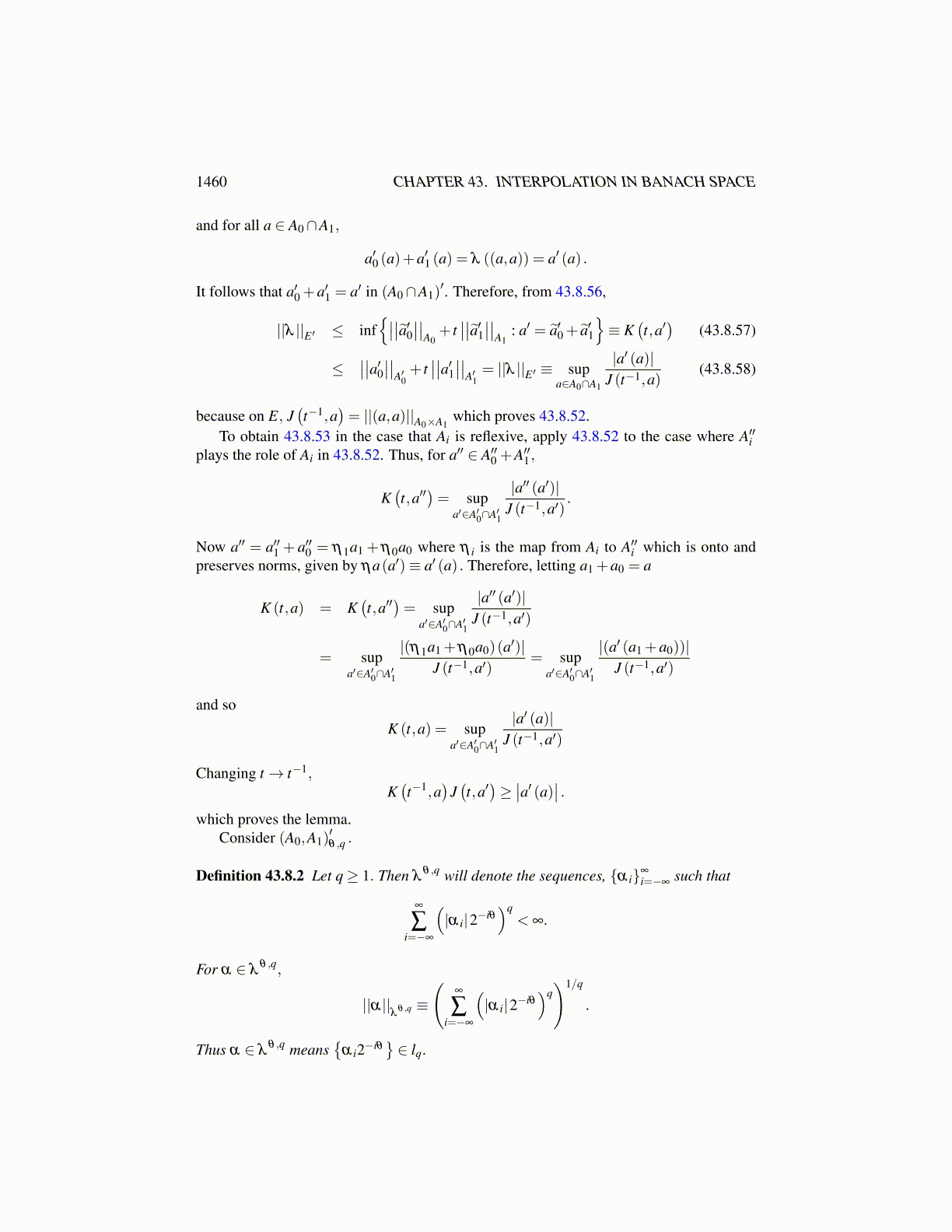
1460 CHAPTER 43. INTERPOLATION IN BANACH SPACE
As mentioned above, A′0+A′1 ⊆ (A0∩A1)′. In fact these two are equal. This is the first part
of the following lemma.
Lemma 43.8.1 Suppose A0∩A1 is dense in Ai, i = 0,1. Then
A′0 +A′1 = (A0∩A1)′ , (43.8.51)
and for a′ ∈ A′0 +A′1 = (A0∩A1)′ ,
K(t,a′)= sup
a∈A0∩A1
|a′ (a)|J (t−1,a)
. (43.8.52)
Thus K (t, ·) is an equivalent norm to the usual operator norm on (A0∩A1)′ taken with
respect to J(t−1, ·
). If, in addition to this, Ai is reflexive, then for a′ ∈ A′0 ∩A′1, and a ∈
A0∩A1,J(t,a′)
K(t−1,a
)≥∣∣a′ (a)∣∣ . (43.8.53)
Proof: First consider the claim that A′0 +A′1 = (A0∩A1)′. As noted above, ⊆ is clear.
Define a norm on A0×A1 as follows.
||(a0,a1)||A0×A1≡max
(||a0||A0
, t−1 ||a1||A1
). (43.8.54)
Let a′ ∈ (A0∩A1)′. Let
E ≡ {(a,a) : a ∈ A0∩A1}
with the norm J(t−1,a
)≡ max
(||a||A0
, t−1 ||a||A1
). Now define λ on E, the subspace of
A0×A1 byλ ((a,a))≡ a′ (a) .
Thus λ is a continuous linear map on E and in fact,
|λ ((a,a))|=∣∣a′ (a)∣∣≤ ∣∣∣∣a′∣∣∣∣J (t−1,a
).
By the Hahn Banach theorem there exists an extension of λ to all of A0×A1. This extensionis of the form (a′0,a
′1) ∈ A′0×A′1. Thus(
a′0,a′1)((a,a)) = a′0 (a)+a′1 (a) = a′ (a)
and therefore, a′0 +a′1 = a′ provided a′0 +a′1 is continuous. But∣∣(a′0 +a′1)(a)∣∣ =
∣∣a′0 (a)+a′1 (a)∣∣≤ ∣∣a′0 (a)∣∣+ ∣∣a′1 (a)∣∣
≤∣∣∣∣a′0∣∣∣∣ ||a||A0
+∣∣∣∣a′1∣∣∣∣ ||a||A1
≤∣∣∣∣a′0∣∣∣∣ ||a||A0
+ t∣∣∣∣a′1∣∣∣∣ t−1 ||a||A1
≤(∣∣∣∣a′0∣∣∣∣+ t
∣∣∣∣a′1∣∣∣∣)J(t−1,a
)which shows that a′0 +a′1 is continuous and in fact∣∣∣∣a′0 +a′1
∣∣∣∣(A0∩A1)
′ ≤(∣∣∣∣a′0∣∣∣∣+ t
∣∣∣∣a′1∣∣∣∣) .